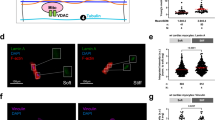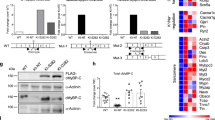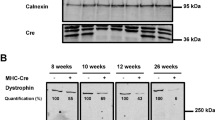Abstract
Familial hypertrophic cardiomyopathy is a clinically and genetically diverse autosomal dominant disorder characterized by ventricular hypertrophy and myocyte disarray in the absence of known hypertrophic stimuli1,2. It has been linked to many cardiac contractile proteins, including four point mutations in α-tropomyosin3,4,5 (Tm). Here we use adenoviral-mediated gene transfer into adult cardiac myocytes in vitro to show that all four hypertrophic cardiomyopathy α-Tm proteins can be expressed and incorporated into normal sarcomeric structures in cardiac myocytes at similar levels as normal α-Tm proteins after 5–6 days in culture. Isometric force recordings of single cardiac myocytes demonstrated inappropriate increased force output at submaximal calcium concentration with a specific mutant allele hierarchy. These data indicate that the severity of direct calcium-sensitizing effect of mutations in α-Tm may predict the clinical severity of mutant α-Tm-associated hypertrophic cardiomyopathy.
This is a preview of subscription content, access via your institution
Access options
Subscribe to this journal
Receive 12 print issues and online access
$209.00 per year
only $17.42 per issue
Buy this article
- Purchase on Springer Link
- Instant access to full article PDF
Prices may be subject to local taxes which are calculated during checkout



Similar content being viewed by others
References
Watkins, H., Seidman, J.G. & Seidman, C.E. Familial hypertrophic cardiomyopathy: a genetic model of cardiac hypertrophy. Hum. Mol. Genet. 4, 1721–1727 (1995).
Bonne, G., Carrier, L., Richard, P., Hainque, B. & Schwartz, K. Familial hypertrophic cardiomyopathy: from mutations to functional defects. Circ. Res. 83, 580–593 (1998).
Thierfelder, L. et al. α-tropomyosin and cardiac troponin T mutations cause hypertrophic cardiomyopathy: a disease of the sarcomere. Cell. 77, 701–712 (1994).
Nakajima-Taniguchi, C., Matsui, H., Nagata, S., Kishimoto, T. & Yamauchi-Takihara, K. Novel missense mutation in α-tropomyosin gene found in Japanese patients with hypertrophic cardiomyopathy. J. Mol. Cell. Cardiol. 27, 2053–2058 (1995).
Yamauchi-Takihara, K. et al. Clinical implications of hypertrophic cardiomyopathy associated with mutations in the α-tropomyosin gene. Heart 76, 63–65 (1996).
Tobacman, L.S. Thin filament-mediated regulation of cardiac contraction. Annu. Rev. Physiol. 58, 447–481 (1996).
Watkins, H. et al. Characteristics and prognostic implications of myosin missense mutations in familial hypertrophic cardiomyopathy. N. Engl. J. Med. 326, 1108–1114 (1992).
Epstein, N.D., Cohn, G.M., Cyran, F. & Fananapazir, L. Differences in clinical expression of hypertrophic cardiomyopathy associated with two distinct mutations in the β-myosin heavy chain gene. Circulation 86, 345–352 (1992).
Watkins, H. et al. Mutations in the genes for cardiac troponin T and α-tropomyosin in hypertrophic cardiomyopathy. N. Eng. J. Med. 332, 1058–1064 (1995).
Westfall, M.V., Rust, E.M., Albayya, F. & Metzger, J.M. Adenovirus mediated myofilament gene transfer into adult cardiac myocytes. Meth. Cell. Biol. 52, 307–322 (1997).
Rust, E.M., Westfall, M.V. & Metzger, J.M. Stability of the contractile assembly and Ca2+ activated tension in adenovirus infected adult cardiac myocytes. Mol. Cell. Biochem. 181, 143–155 (1998).
Michele, D.E., Albayya, F.P. & Metzger, J.M. Thin filament protein dynamics in fully differentiated adult cardiac myocytes: toward a model of sarcomere maintenance. J. Cell Biol. 145, 1483–1495 (1999).
Martin, A.F. Turnover of cardiac troponin subunits. J. Biol. Chem. 256, 964–968 (1981).
White, S.P., Cohen, C. & Phillips, G.N. Structure of co-crystals of tropomyosin and troponin. Nature 325, 826–828 (1987).
Golitsina, N. et al. Effects of two familial hypertrophic cardiomyopathy causing mutations on α-tropomyosin structure and function. Biochemistry 36, 4637–4642 (1997); erratum: 38, 3850 (1999).
McLachlan, A.D. & Stewart, M. Tropomyosin coiled-coil interactions: evidence for an unstaggered structure. J. Mol. Biol. 98, 293–304 (1975).
McKillop. D.F.A. & Geeves, M.A. Regulation of the interaction between actin and myosin subfragment 1: evidence for three states of the thin filament. Biophys. J. 65, 693–701 (1993).
Coviello, D.A. et al. Clinical features of hypertrophic cardiomyopathy caused by a mutation of a "hot spot" in the alpha-tropomyosin gene. J. Am. Coll. Cardiol. 29, 635–640 (1997).
Thierfelder, L. et al. A familial hypertrophic cardiomyopathy locus maps to chromosome 15q2. Proc. Natl. Acad. Sci. USA 90, 6720–6274 (1993).
Muthuchamy, M. et al. Mouse model of a familial hypertrophic cardiomyopathy mutation in α-tropomyosin manifests cardiac dysfunction. Circ. Res. 85, 47–56 (1999).
Bing, W. et al. Effects of two hypertrophic cardiomyopathy mutations in α-tropomyosin, Asp175Asn and Glu180Gly, on Ca2+ regulation of thin filament motility. Biochem. Biophys. Res. Comm. 236, 760–764 (1997).
Bottinelli, R. et al. A mutant tropomyosin that causes hypertrophic cardiomyopathy is expressed in vivo and associated with an increased calcium sensitivity. Circ. Res. 82, 106–115 (1998).
Rust, E.M., Albayya, F.P. & Metzger, J.M. Identification of a contractile deficit in adult cardiac myocytes expressing hypertrophic cardiomyopathy-associated mutant troponin T proteins. J. Clin. Invest. 103, 1459–1467 (1999).
MacLeod, A.R. & Gooding, C. Human hTmα gene: expression in muscle and non-muscle tissue. Mol. Cell. Biol. 8, 433–440 (1988).
Metzger, J. M. et al. Skeletal troponin C reduces contractile sensitivity to acidosis in cardiac myocytes from transgenic mice. Proc. Natl. Acad. Sci. USA 90, 9036–9040 (1993).
Acknowledgements
This work was funded by grants from the National Institutes of Health and the American Heart Association to J.M. and National Institutes of Health training grants to D.M.. J.M. is an Established Investigator of the American Heart Association.
Author information
Authors and Affiliations
Corresponding author
Rights and permissions
About this article
Cite this article
Michele, D., Albayya, F. & Metzger, J. Direct, convergent hypersensitivity of calcium-activated force generation produced by hypertrophic cardiomyopathy mutant α-tropomyosins in adult cardiac myocytes. Nat Med 5, 1413–1417 (1999). https://doi.org/10.1038/70990
Received:
Accepted:
Issue Date:
DOI: https://doi.org/10.1038/70990
This article is cited by
-
Emerging pharmacologic and structural therapies for hypertrophic cardiomyopathy
Heart Failure Reviews (2017)
-
Myofilament lattice structure in presence of a skeletal myopathy-related tropomyosin mutation
Journal of Muscle Research and Cell Motility (2013)
-
Nuclear tropomyosin and troponin in striated muscle: new roles in a new locale?
Journal of Muscle Research and Cell Motility (2013)
-
Alpha-tropomyosin mutations in inherited cardiomyopathies
Journal of Muscle Research and Cell Motility (2013)
-
Mechanisms of disease: hypertrophic cardiomyopathy
Nature Reviews Cardiology (2012)



